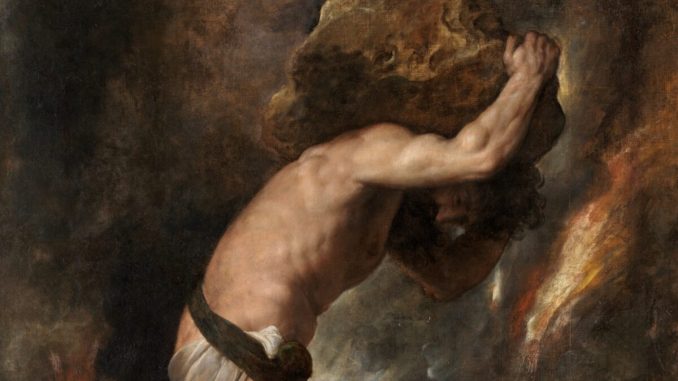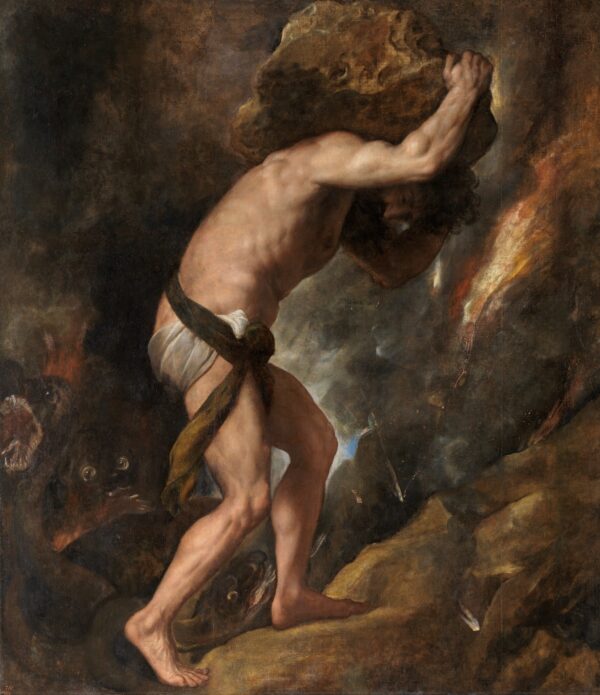
Sometimes we find ourselves addicted to substances, emotions, and ways of thinking that keep us far from experiencing any semblance of inner peace.
I came across a painting by Titian of Sisyphus that made me reflect on the nature of our addictions.
Sisyphus Twice Cheats Death
In Greek legend, Sisyphus was the sly and deceitful king of Corinth. He helped Corinth prosper commercially, but he often refused to show guests to his city the decency and hospitality required by Zeus. He would even kill his guests to prove that he was a king to be feared.
Zeus was disappointed in Sisyphus’s cruelty. Interestingly enough, Zeus was further angered when Sisyphus told the river god Asopus where Zeus had taken the river god’s kidnapped daughter.
Revealing the god’s secrets went a step too far, and Zeus decided it was time to punish Sisyphus. In one version of the story, Zeus asked Thanatos, the personification of death, to chain Sisyphus in the underworld.
Thanatos captured Sisyphus and prepared to chain him up when Sisyphus asked Thanatos to demonstrate how the chains worked. Thanatos agreed to show him, and Sisyphus quickly chained Thanatos instead. Sisyphus successfully escaped death.
With Thanatos chained up, mortals no longer died. It took Ares, the god of war, to restore the balance between life and death. Ares also trapped Sisyphus and returned him to Thanatos to receive his punishment for the second time. But before he was returned, Sisyphus was already planning his second escape from death.
Upon his death, Sisyphus asked his wife not to provide him with the usual sacrifices and offerings required for a husband’s death. Then, in the underworld, he pleaded with the kindhearted Persephone, the wife of Hades, to let him go back to his wife and instruct her on the proper burial procedure. Sisyphus’s plan worked, and he was again among the living with no intention of returning to the underworld.
Intervening himself, Zeus made sure that Sisyphus would not escape the next time he entered the underworld. Sisyphus was made to suffer for eternity by forever pushing a boulder uphill, only to have it fall back down to the bottom of the hill after reaching the summit.

Titian’s ‘Sisyphus’
In the mid-16th century, the Italian Renaissance painter Titian painted his rendition of Sisyphus’s punishment for Mary of Hungary, then queen of Hungary and Bohemia.
The Prado Museum website reveals that Mary of Hungary had many images from Greek legends on the walls of the Great Room in the Palace of Binche, indicating “the coherence of an iconographic program whose main idea was to emphasize the misery and endless punishment of those who rise up against the gods.”
In his painting “Sisyphus,” Titian depicted Sisyphus walking up a jagged incline. He is covered with a meager cloth, and he does not push the boulder to the top of the hill but carries it on his shoulders and head, causing his shoulders and head to lean forward under its weight.
The frame of the composition also imposes itself on Sisyphus’s body. The top of the boulder and his feet come right to the edge of the composition’s top and bottom, further giving a sense of Sisyphus’s suffocating fate.
The environment is hellish. Weird creatures occupy the bottom left of the composition, and fire and smoke fill the background. A snake appears to threaten Sisyphus’s feet as if the threat forces him to hurry to the top of the hill.
The Weight of Our Addictions
Three things immediately stand out to me in this painting: the fact that Sisyphus is carrying the boulder instead of pushing it, the snake that threatens him from below, and the imposing nature of the composition’s edges. Let’s look at each element to see what moral insight they might provide.
When I see Sisyphus carrying the boulder instead of pushing it, I immediately think of our addictions. Our addictions often start as small interests or desires, and with time, they become something outside of our control.
For instance, what may start as drinking for fun may turn into the burden of alcoholism, or occasional bets on sports may somehow evolve into a home’s foreclosure. Our addictions can also be subtle: A prideful thought or furtive glance that induces satisfying feelings can, over time, become feelings that we crave, as though we are actually addicted.
Like Sisyphus having to ascend the hill repeatedly, we try to overcome our addictions repeatedly. We push ourselves to the limit in an attempt to let go and be free of them, but we relapse, or we find that the addiction is deeper than we initially thought. We then find ourselves carrying a boulder uphill again.
The boulder not only causes Sisyphus’s head and shoulders to contort under its weight, but it also prevents light from reaching his head and chest, representative of his heart and mind. The weight we carry from our addictions can consume our hearts and minds, obscuring light and preventing it from entering our lives.
What might the snake at Sisyphus’s heel represent? Along with everything else, the snake is only there as part of Sisyphus’s punishment. Threatening his heel, the snake prevents him from ever resting, from ever finding peace.
Finally, what might Sisyphus’s position in relation to the edges of the composition represent? The edges almost serve as a prison that amplifies Sisyphus’s lack of freedom.
Not only does the weight of the boulder press on his head and shoulders, but the top edge of the composition seems to add its own weight, a weight so heavy that Sisyphus doesn’t seem like he could stand up straight if he wanted to.
The four edges of the composition encapsulate everything depicted. To me, they represent the environment’s effect on Sisyphus. It’s not just the boulder’s weight that Sisyphus must continuously carry, but he must also constantly confront the restrictions placed on him by the environment, and these restrictions seem to further prevent him from experiencing true freedom.
Sisyphus was condemned to suffer for eternity, but what about us? How might we identify the true sources of our addictions? Is there a way out of the addictions that may frame our lives? How might we find peace from the heavy burdens we may carry?
The traditional arts often contain spiritual representations and symbols the meanings of which can be lost to our modern minds. In our series “Reaching Within: What Traditional Art Offers the Heart,” we interpret visual arts in ways that may be morally insightful for us today. We do not assume to provide absolute answers to questions generations have wrestled with, but hope that our questions will inspire a reflective journey toward our becoming more authentic, compassionate, and courageous human beings.
Eric Bess is a practicing representational artist and is a doctoral candidate at the Institute for Doctoral Studies in the Visual Arts (IDSVA).





Be the first to comment